Robust Composites Based on Silicone Rubber for Self-Powered Piezoelectric Nanogenerators
Abstract
1. Introduction
2. Experimental Section
2.1. Materials Used in This Work
2.2. Characterization Section
2.3. Fabrication of Composites
3. Results and Discussion
3.1. Filler Dispersion
3.2. Mechanical Properties Under Static Compressive Strain
3.3. Mechanical Properties Under Static Tensile Strain
3.4. Mechanical Properties Under Cyclic Compressive Strain
3.5. Electro-Mechanical Properties Under Cyclic Compressive Strain
3.6. Tuning of Stiffness and Output Voltage Under Cyclic Compressive Strain
3.7. Capacitance Under Compressive Cyclic Strain
3.8. Energy Analysis and Piezoelectric Coefficients of PENGs
3.9. Real-Time Monitoring of PENGs
3.10. Mechanical and Electro-Mechanical Durability Tests
4. Conclusions
Author Contributions
Funding
Institutional Review Board Statement
Data Availability Statement
Conflicts of Interest
References
- Olabi, A.G.; Abbas, Q.; Shinde, P.A.; Abdelkareem, M.A. Rechargeable batteries: Technological advancement, challenges, current and emerging applications. Energy 2023, 266, 126408. [Google Scholar]
- Hu, D.; Yao, M.; Fan, Y.; Ma, C.; Fan, M.; Liu, M. Strategies to achieve high performance piezoelectric nanogenerators. Nano Energy 2019, 55, 288–304. [Google Scholar]
- Owusu, F.; Venkatesan, T.R.; Nüesch, F.A.; Negri, R.M.; Opris, D.M. How to Make Elastomers Piezoelectric? Adv. Mater. Technol. 2023, 8, 2300099. [Google Scholar] [CrossRef]
- Wu, M.; Zhu, C.; Liu, X.; Wang, H.; Si, J.; Xu, M.; Mi, J. Recent advances in nanogenerators driven by flow-induced vibrations for harvesting energy. Mater. Today Energy 2024, 41, 101529. [Google Scholar]
- Dong, K.; Peng, X.; Wang, Z.L. Fiber/fabric-based piezoelectric and triboelectric nanogenerators for flexible/stretchable and wearable electronics and artificial intelligence. Adv. Mater. 2020, 32, 1902549. [Google Scholar]
- Kumar, V.; Manikkavel, A.; Yewale, M.A.; Alam, M.N.; Park, S.S. Lightweight, compressible, stretchable, ultra-soft, and mechanically stable composites for piezo-electric energy generators and strain sensing. Mater. Res. Bull. 2024, 179, 112962. [Google Scholar] [CrossRef]
- Bhadwal, N.; Ben Mrad, R.; Behdinan, K. Review of zinc oxide piezoelectric nanogenerators: Piezoelectric properties, composite structures and power output. Sensors 2023, 23, 3859. [Google Scholar] [CrossRef] [PubMed]
- Hu, S.; Shi, Z.; Zhao, W.; Wang, L.; Yang, G. Multifunctional piezoelectric elastomer composites for smart biomedical or wearable electronics. Compos. Part B Eng. 2019, 160, 595–604. [Google Scholar] [CrossRef]
- Hu, Y.; Wang, Z.L. Recent progress in piezoelectric nanogenerators as a sustainable power source in self-powered systems and active sensors. Nano Energy 2015, 14, 3–14. [Google Scholar]
- Singh, P.K.; Kaur, G.A.; Shandilya, M.; Rana, P.; Rai, R.; Mishra, Y.K.; Tiwari, A. Trends in piezoelectric nanomaterials towards green energy scavenging nanodevices. Mater. Today Sustain. 2023, 24, 100583. [Google Scholar] [CrossRef]
- Nguyen, Q.H.; Ta QT, H.; Tran, N. Review on the transformation of biomechanical energy to green energy using triboelectric and piezoelectric based smart materials. J. Clean. Prod. 2022, 371, 133702. [Google Scholar] [CrossRef]
- Hu, Y.; Lin, L.; Zhang, Y.; Wang, Z.L. Replacing a battery by a nanogenerator with 20 V output. Adv. Mater. 2012, 24, 110–114. [Google Scholar] [CrossRef] [PubMed]
- Zhao, Z.; Dai, Y.; Dou, S.X.; Liang, J. Flexible nanogenerators for wearable electronic applications based on piezoelectric materials. Mater. Today Energy 2021, 20, 100690. [Google Scholar] [CrossRef]
- Kumar, V.; Alam, M.N.; Manikkavel, A.; Song, M.; Lee, D.J.; Park, S.S. Silicone rubber composites reinforced by carbon nanofillers and their hybrids for various applications: A review. Polymers 2021, 13, 2322. [Google Scholar] [CrossRef] [PubMed]
- Bhatt, A.; Singh, V.; Bamola, P.; Aswal, D.; Rawat, S.; Rana, S.; Sharma, H. Enhanced piezoelectric response using TiO2/MoS2 heterostructure nanofillers in PVDF based nanogenerators. J. Alloys Compd. 2023, 960, 170664. [Google Scholar] [CrossRef]
- Möls, K.; Aarik, L.; Mändar, H.; Kasikov, A.; Niilisk, A.; Rammula, R.; Aarik, J. Influence of phase composition on optical properties of TiO2: Dependence of refractive index and band gap on formation of TiO2-II phase in thin films. Opt. Mater. 2019, 96, 109335. [Google Scholar] [CrossRef]
- Latief, U.; Mondal, S.; Aishwarya, A.; Bhattacharjee, N.; Bhattacharyya, A.R. Hybrid Fillers of Barium Titanate and Functionalized Multi-Walled Carbon Nanotubes Incorporated Poly (vinylidene fluoride) Nanocomposites for Piezoelectric Nanogenerators. ACS Appl. Nano Mater. 2025, 8, 4784–4800. [Google Scholar] [CrossRef]
- Yun, J.; Park, J.; Ryoo, M.; Kitchamsetti, N.; Goh, T.S.; Kim, D. Piezo-triboelectric hybridized nanogenerator embedding MXene based bifunctional conductive filler in polymer matrix for boosting electrical power. Nano Energy 2023, 105, 108018. [Google Scholar] [CrossRef]
- Chung, K.Y.; Xu, B.; Li, Z.; Liu, Y.; Han, J. Bioinspired ultra-stretchable dual-carbon conductive functional polymer fiber materials for health monitoring, energy harvesting and self-powered sensing. Chem. Eng. J. 2023, 454, 140384. [Google Scholar] [CrossRef]
- Kumar, V.; Alam, M.N.; Yewale, M.A.; Lee, D.J.; Park, S.S. Mimicking self-powered piezoelectric energy-generating behavior in silicone rubber composites under compressive and tensile strains. ACS Appl. Electron. Mater. 2024, 6, 1638–1650. [Google Scholar] [CrossRef]
- Kumar, V.; Sood, A.; Kumar, A.; Yewale, M.A.; Alam, M.N.; Park, S.S. Modulating the energy harvesting with tunable hardness from mildly functionalized graphite nanoplatelets-based composites for wearable applications. J. Alloys Compd. 2025, 1010, 177517. [Google Scholar] [CrossRef]
- DIN 53504:2017-03; Testing of Rubber—Determination of Tensile Strength at Break, Tensile Stress at Yield, Elongation at Break and Stress Values in a Tensile Test. DIN Media GmbH: Berlin, Germany, 2017.
- Lee, G.; Jang, H.G.; Cho, S.Y.; Joh, H.I.; Lee, D.C.; Kim, J.; Lee, S. Polyethylene-derived high-yield carbon material for upcycling plastic wastes as a high-performance composite filler. Compos. Part C Open Access 2024, 13, 100429. [Google Scholar] [CrossRef]
- Yang, T.; Wang, C.; Liu, L.; Zhang, L. Silicone elastomer dielectric composites by introducing novel O-MMT@ TiO2 nanoparticles for energy harvesting application. Compos. Part A Appl. Sci. Manuf. 2024, 185, 108351. [Google Scholar] [CrossRef]
- Jiang, S.; Yong, Z. Modulation of Mechanical Properties of Silica-Filled Silicone Rubber by Cross-Linked Network Structure. Polymers 2024, 16, 2304. [Google Scholar] [CrossRef] [PubMed]
- Mobtasem, M.; Abd-Elhady, A.A.; Sallam, H.E.D.M. Implementation of a new approach based on the functionally graded materials concept to improve the strength of laminated composites containing open-hole. Polym. Compos. 2024, 45, 12132–12146. [Google Scholar] [CrossRef]
- Zeng, Y.; Xiong, C.; Li, J.; Huang, Z.; Du, G.; Fan, Z.; Chen, N. Structural, dielectric and mechanical behaviors of (La, Nb) Co-doped TiO2/Silicone rubber composites. Ceram. Int. 2021, 47, 22365–22372. [Google Scholar] [CrossRef]
- Liu, J.; Yao, Y.; Chen, S.; Li, X.; Zhang, Z. A new nanoparticle-reinforced silicone rubber composite integrating high strength and strong adhesion. Compos. Part A Appl. Sci. Manuf. 2021, 151, 106645. [Google Scholar] [CrossRef]
- Yang, S.; Li, R.; Zhu, H.; Zhang, F.; Yang, X.; Tan, Q.; Du, J. Fabrication of an Environmentally Friendly Modifier Based on DAh-MT-MoS2 via Codeposition for the Preparation of Composite TB Rubberized Asphalt. J. Mater. Civ. Eng. 2025, 37, 04024544. [Google Scholar] [CrossRef]
- Kumar, V.; Kumar, A.; Song, M.; Lee, D.J.; Han, S.S.; Park, S.S. Properties of silicone rubber-based composites reinforced with few-layer graphene and iron oxide or titanium dioxide. Polymers 2021, 13, 1550. [Google Scholar] [CrossRef]
- Borgaonkar, A.V.; Ismail, S. Tribological behavior prediction of composite MoS2-TiO2 coating using Taguchi coupled artificial neural network approach. Proc. Inst. Mech. Eng. 2022 Part C J. Mech. Eng. Sci. 2022, 236, 6835–6850. [Google Scholar] [CrossRef]
- Sethurajaperumal, A.; Srivastava, S.; Ganesh, G.; Sundara, R.; Varrla, E. Natural surfactant stabilized aqueous MoS2 nano-lubricants for reducing friction and wear. Chem. Eng. J. 2024, 496, 154080. [Google Scholar] [CrossRef]
- Kumar, V.; Alam, M.N.; Park, S.S. Review of Recent Progress on Silicone Rubber Composites for Multifunctional Sensor Systems. Polymers 2024, 16, 1841. [Google Scholar] [CrossRef] [PubMed]
- Leng, D.X.; Huang, C.; Xu, K.; Ma, Y.; Liu, G.J.; Li, Z.X. Experimental mechanics and numerical prediction on stress relaxation and unrecoverable damage characteristics of rubber materials. Polym. Test. 2021, 98, 107183. [Google Scholar] [CrossRef]
- Mogbojuri, G.; Abtahi, S.; Hendeniya, N.; Chang, B. The Effects of Chain Conformation and Nanostructure on the Dielectric Properties of Polymers. Materials 2025, 18, 198. [Google Scholar] [CrossRef] [PubMed]
- Nawaz, H.; Umar, M.; Maryam, R.; Nawaz, I.; Razzaq, H.; Malik, T.; Liu, X. Polymer Nanocomposites based on TiO2 as a reinforcing agent: An Overview. Adv. Eng. Mater. 2022, 24, 2200844. [Google Scholar] [CrossRef]
- Shirvanimoghaddam, K.; Balaji, K.V.; Yadav, R.; Zabihi, O.; Ahmadi, M.; Adetunji, P.; Naebe, M. Balancing the toughness and strength in polypropylene composites. Compos. Part B Eng. 2021, 223, 109121. [Google Scholar] [CrossRef]
- Kumar, V.; Alam, M.N.; Yewale, M.A.; Park, S.S. Multifunctional Aspects of Mechanical and Electromechanical Properties of Composites Based on Silicone Rubber for Piezoelectric Energy Harvesting Systems. Polymers 2024, 16, 2058. [Google Scholar] [CrossRef] [PubMed]
- Qian, C.; Chen, J.; Wang, S.; Wang, M.; Song, S. Molecular dynamics investigation on the thermal-oxidative aging and mechanical properties of nitrile butadiene rubber composites with molybdenum disulfide. Appl. Phys. A 2024, 130, 256. [Google Scholar] [CrossRef]
- Chen, Z.; Zhang, M.; Guo, Z.; Chen, H.; Yan, H.; Ren, F.; Ren, P. Synergistic effect of novel hyperbranched polysiloxane and Ti3C2Tx MXene/MoS2 hybrid filler towards desirable mechanical and tribological performance of bismaleimide composites. Compos. Part B Eng. 2023, 248, 110374. [Google Scholar] [CrossRef]
- Zhai, W.; Bai, L.; Zhou, R.; Fan, X.; Kang, G.; Liu, Y.; Zhou, K. Recent progress on wear-resistant materials: Designs, properties, and applications. Adv. Sci. 2021, 8, 2003739. [Google Scholar] [CrossRef]
- Persson, A.M.M.R.; Andreassen, E. Cyclic compression testing of three elastomer types—A thermoplastic vulcanizate elastomer, a liquid silicone rubber and two ethylene-propylene-diene rubbers. Polymers 2022, 14, 1316. [Google Scholar] [CrossRef] [PubMed]
- Zeng, Y.; Tang, L. Improved dielectric and mechanical properties in Ti3C2Tx MXene-MoS2/Methyl vinyl silicone rubber composites as flexible dielectric materials. J. Alloys Compd. 2023, 948, 169733. [Google Scholar] [CrossRef]
- Uddin, A.; Estevez, D.; Khatoon, R.; Qin, F. Thermally Stable Silicone Elastomer Composites Based on MoS2@ Biomass-Derived Carbon with a High Dielectric Constant and Ultralow Loss for Flexible Microwave Electronics. ACS Appl. Mater. Interfaces 2023, 15, 27144–27155. [Google Scholar] [CrossRef] [PubMed]
- Singh, S.; Pal, K. Investigation on microstructural, mechanical and damping properties of SiC/TiO2, SiC/Li4Ti5O12 reinforced Al matrix. Ceram. Int. 2021, 47, 14809–14820. [Google Scholar] [CrossRef]
- Sethulekshmi, A.S.; Saritha, A.; Joseph, K. A comprehensive review on the recent advancements in natural rubber nanocomposites. Int. J. Biol. Macromol. 2022, 194, 819–842. [Google Scholar] [CrossRef] [PubMed]
- Deng, H.T.; Wen, D.L.; Feng, T.; Wang, Y.L.; Zhang, X.R.; Huang, P.; Zhang, X.S. Silicone rubber based-conductive composites for stretchable “all-in-one” microsystems. ACS Appl. Mater. Interfaces 2022, 14, 39681–39700. [Google Scholar] [CrossRef]
- Jin, L.; Zhang, C.; Guo, H.; Wang, H.; Bai, J.; Zhao, H. Improved electro-actuation of polydimethylsiloxane-based composite dielectric elastomer via constructing semi-interlocked dual-network. Polymer 2025, 317, 127937. [Google Scholar] [CrossRef]
- Rius-Bartra, J.M.; Ferrer-Serrano, N.; Agulló, N.; Borrós, S. High-consistency silicone rubber with reduced Young’s modulus. An industrial option to dielectric silicone rubber. J. Appl. Polym. Sci. 2023, 140, e54405. [Google Scholar]
- Afolabi, O.A.; Ndou, N. Synergy of Hybrid Fillers for Emerging Composite and Nanocomposite Materials—A Review. Polymers 2024, 16, 1907. [Google Scholar] [CrossRef]
- Riaz, A.; Sarker, M.R.; Saad, M.H.M.; Mohamed, R. Review on comparison of different energy storage technologies used in micro-energy harvesting, WSNs, low-cost microelectronic devices: Challenges and recommendations. Sensors 2021, 21, 5041. [Google Scholar] [CrossRef] [PubMed]
- Zheng, S.; Guo, H.; Pan, F.; Meng, F.; Jiang, H.; Ruan, L.; Lu, W. Breathable, durable, flexible, and battery-free full action response electronic textiles toward simply achieving the function of human skin. Nano Energy 2024, 122, 109292. [Google Scholar] [CrossRef]
- Ouyang, Y.; Bai, L.; Tian, H.; Li, X.; Yuan, F. Recent progress of thermal conductive ploymer composites: Al2O3 fillers, properties and applications. Compos. Part A Appl. Sci. Manuf. 2022, 152, 106685. [Google Scholar] [CrossRef]
- Abass, B.A.; Hunain, M.B.; Khudair, J.M. Effects of Titanium Dioxide Nanoparticles on the Mechanical Strength of Epoxy Hybrid Composite Materials Reinforced with Unidirectional Carbon and Glass Fibers. IOP Conf. Ser. Mater. Sci. Eng. 2021, 1094, 012159. [Google Scholar] [CrossRef]
- Lei, R.; Gao, F.; Yuan, J.; Jiang, C.; Fu, X.; Feng, W.; Liu, P. Free layer-dependent piezoelectricity of oxygen-doped MoS2 for the enhanced piezocatalytic hydrogen evolution from pure water. Appl. Surf. Sci. 2022, 576, 151851. [Google Scholar] [CrossRef]
- Yun, G.; Tang, S.Y.; Lu, H.; Zhang, S.; Dickey, M.D.; Li, W. Hybrid-filler stretchable conductive composites: From fabrication to application. Small Sci. 2021, 1, 2000080. [Google Scholar] [CrossRef]
- Xu, Q.; Wen, J.; Qin, Y. Development and outlook of high output piezoelectric nanogenerators. Nano Energy 2021, 86, 106080. [Google Scholar] [CrossRef]
- Fu, B.; Li, J.; Jiang, H.; He, X.; Ma, Y.; Wang, J.; Hu, C. Modulation of electric dipoles inside electrospun BaTiO3@ TiO2 core-shell nanofibers for enhanced piezo-photocatalytic degradation of organic pollutants. Nano Energy 2022, 93, 106841. [Google Scholar] [CrossRef]
- Das, T.; Yadav, M.K.; Dev, A.; Kar, M. Double perovskite-based wearable ternary nanocomposite piezoelectric nanogenerator for self-charging, human health monitoring and temperature sensor. Chem. Eng. J. 2024, 496, 153926. [Google Scholar] [CrossRef]
- Deng, W.; Zhou, Y.; Libanori, A.; Chen, G.; Yang, W.; Chen, J. Piezoelectric nanogenerators for personalized healthcare. Chem. Soc. Rev. 2022, 51, 3380–3435. [Google Scholar] [CrossRef]
- Nurazzi, N.M.; Asyraf, M.R.M.; Fatimah Athiyah, S.; Shazleen, S.S.; Rafiqah, S.A.; Harussani, M.M.; Khalina, A. A review on mechanical performance of hybrid natural fiber polymer composites for structural applications. Polymers 2021, 13, 2170. [Google Scholar] [CrossRef] [PubMed]
- Nasrin, K.; Sudharshan, V.; Subramani, K.; Sathish, M. Insights into 2D/2D MXene heterostructures for improved synergy in structure toward next-generation supercapacitors: A review. Adv. Funct. Mater. 2022, 32, 2110267. [Google Scholar] [CrossRef]
- Fan, L.; Yang, L.; Zhao, D.; Ma, L.; He, C.; He, F.; Zhao, N. Balancing Strength and Ductility in Al Matrix Composites Reinforced by Few-Layered MoS2 through In-Situ Formation of Interfacial Al12Mo. Materials 2021, 14, 3561. [Google Scholar] [CrossRef] [PubMed]
- Sezer, N.; Koç, M. A comprehensive review on the state-of-the-art of piezoelectric energy harvesting. Nano Energy 2021, 80, 105567. [Google Scholar] [CrossRef]
- Selleri, G.; Gino, M.E.; Brugo, T.M.; D’Anniballe, R.; Tabucol, J.; Focarete, M.L.; Zucchelli, A. Self-sensing composite material based on piezoelectric nanofibers. Mater. Des. 2022, 219, 110787. [Google Scholar] [CrossRef]
- Wu, N.; Bao, B.; Wang, Q. Review on engineering structural designs for efficient piezoelectric energy harvesting to obtain high power output. Eng. Struct. 2021, 235, 112068. [Google Scholar]
- Zhang, Y.; Qi, H.; Sun, S.; Liu, Y.; Gao, B.; Wang, L.; Chen, J. Ultrahigh piezoelectric performance benefiting from quasi-isotropic local polarization distribution in complex lead-based perovskite. Nano Energy 2022, 104, 107910. [Google Scholar] [CrossRef]
- Han, K.W.; Kim, J.N.; Rajabi-Abhari, A.; Bui, V.T.; Kim, J.S.; Choi, D.; Oh, I.K. Long-lasting and steady triboelectric energy harvesting from low-frequency irregular motions using escapement mechanism. Adv. Energy Mater. 2021, 11, 2002929. [Google Scholar]
- Dani, S.S.; Tripathy, A.; Alluri, N.R.; Balasubramaniam, S.; Ramadoss, A. A critical review: The impact of electrical poling on the longitudinal piezoelectric strain coefficient. Mater. Adv. 2022, 3, 8886–8921. [Google Scholar]
- Zhao, C.; Benčan, A.; Bohnen, M.; Zhuo, F.; Ma, X.; Dražić, G.; Rödel, J. Impact of stress-induced precipitate variant selection on anisotropic electrical properties of piezoceramics. Nat. Commun. 2024, 15, 10327. [Google Scholar]
- Ali, Z.; Yaqoob, S.; Yu, J.; D’Amore, A. Critical review on the characterization, preparation, and enhanced mechanical, thermal, and electrical properties of carbon nanotubes and their hybrid filler polymer composites for various applications. Compos. Part C Open Access 2024, 13, 100434. [Google Scholar] [CrossRef]
- Ramesh, M.; Rajeshkumar, L.N.; Srinivasan, N.; Kumar, D.V.; Balaji, D. Influence of filler material on properties of fiber-reinforced polymer composites: A review. E-Polymers 2022, 22, 898–916. [Google Scholar] [CrossRef]
- Nagaraja, S.; Anand, P.B.; Ammarullah, M.I. Influence of fly ash filler on the mechanical properties and water absorption behaviour of epoxy polymer composites reinforced with pineapple leaf fibre for biomedical applications. RSC Adv. 2024, 14, 14680–14696. [Google Scholar] [CrossRef] [PubMed]
- Liang, T.; Yuan, Y.J. Wearable medical monitoring systems based on wireless networks: A review. IEEE Sens. J. 2016, 16, 8186–8199. [Google Scholar] [CrossRef]
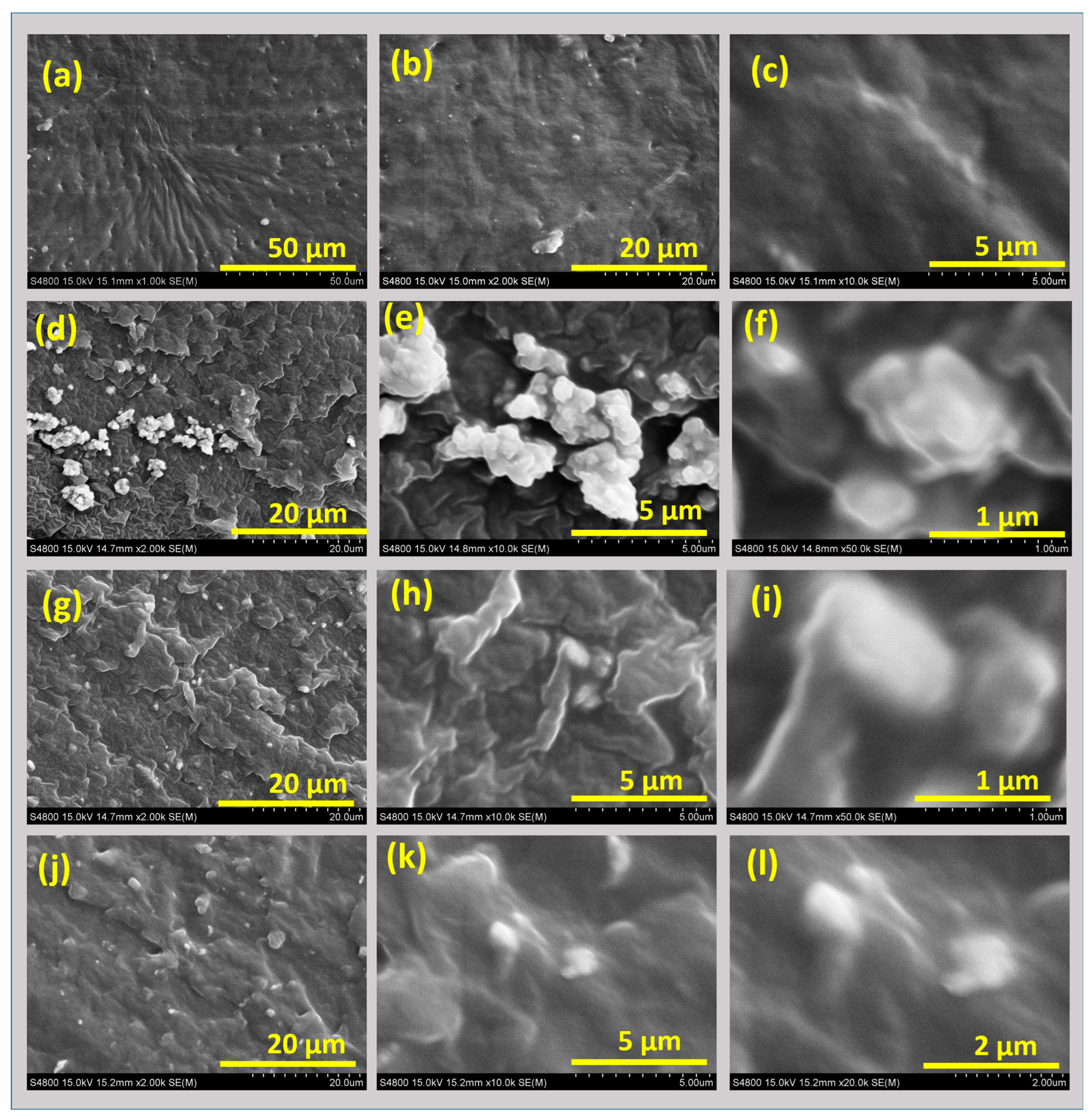
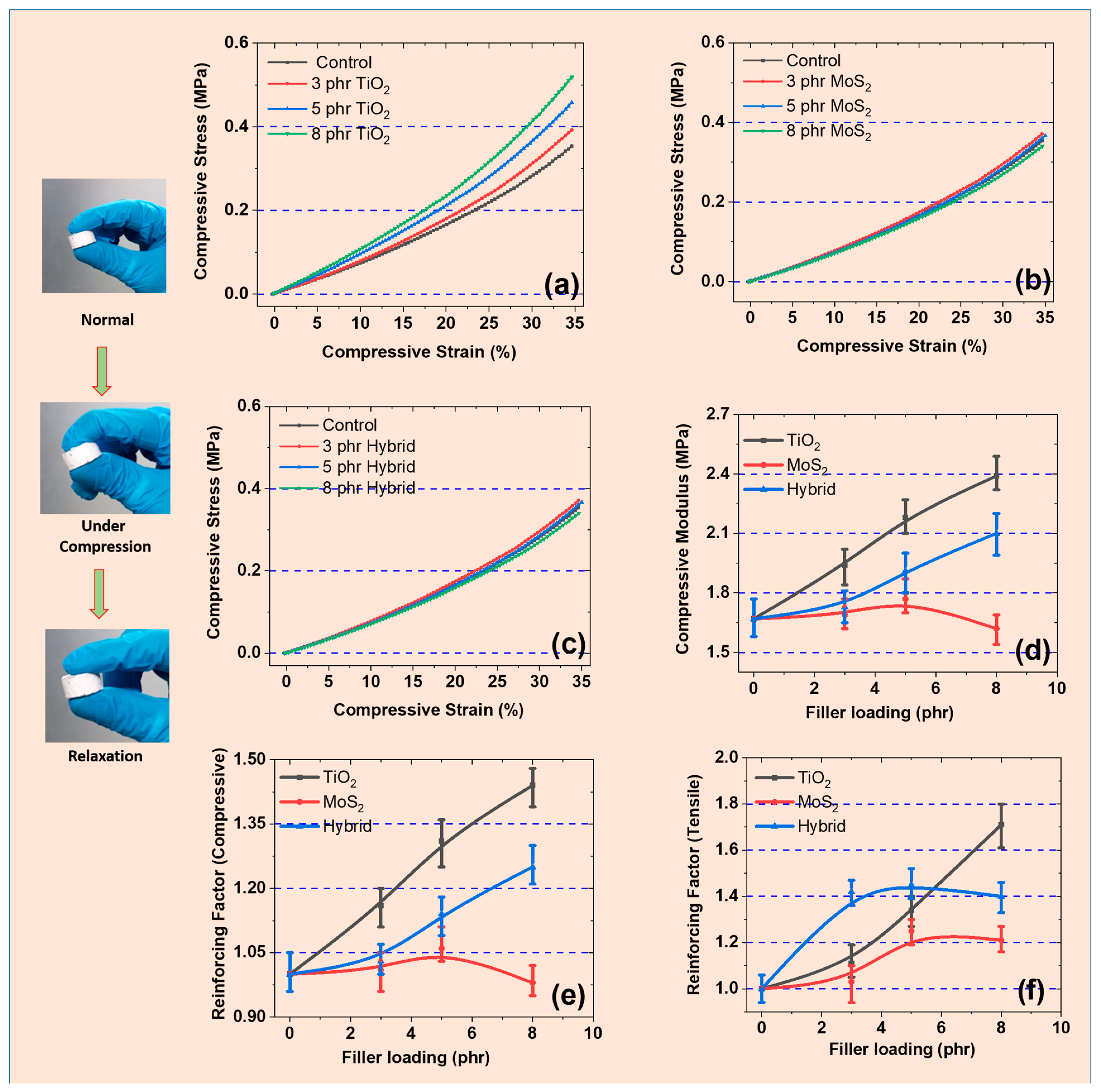

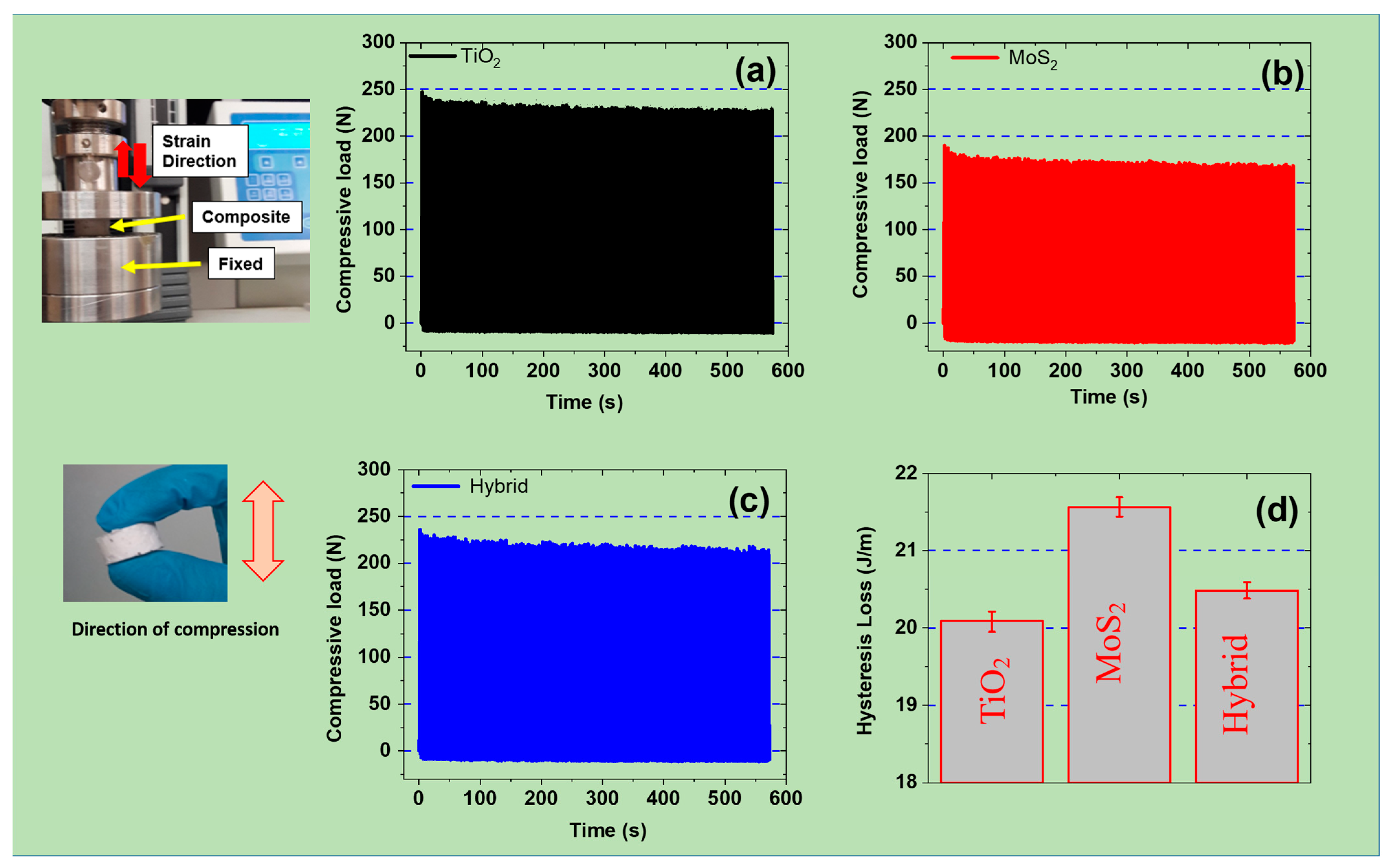

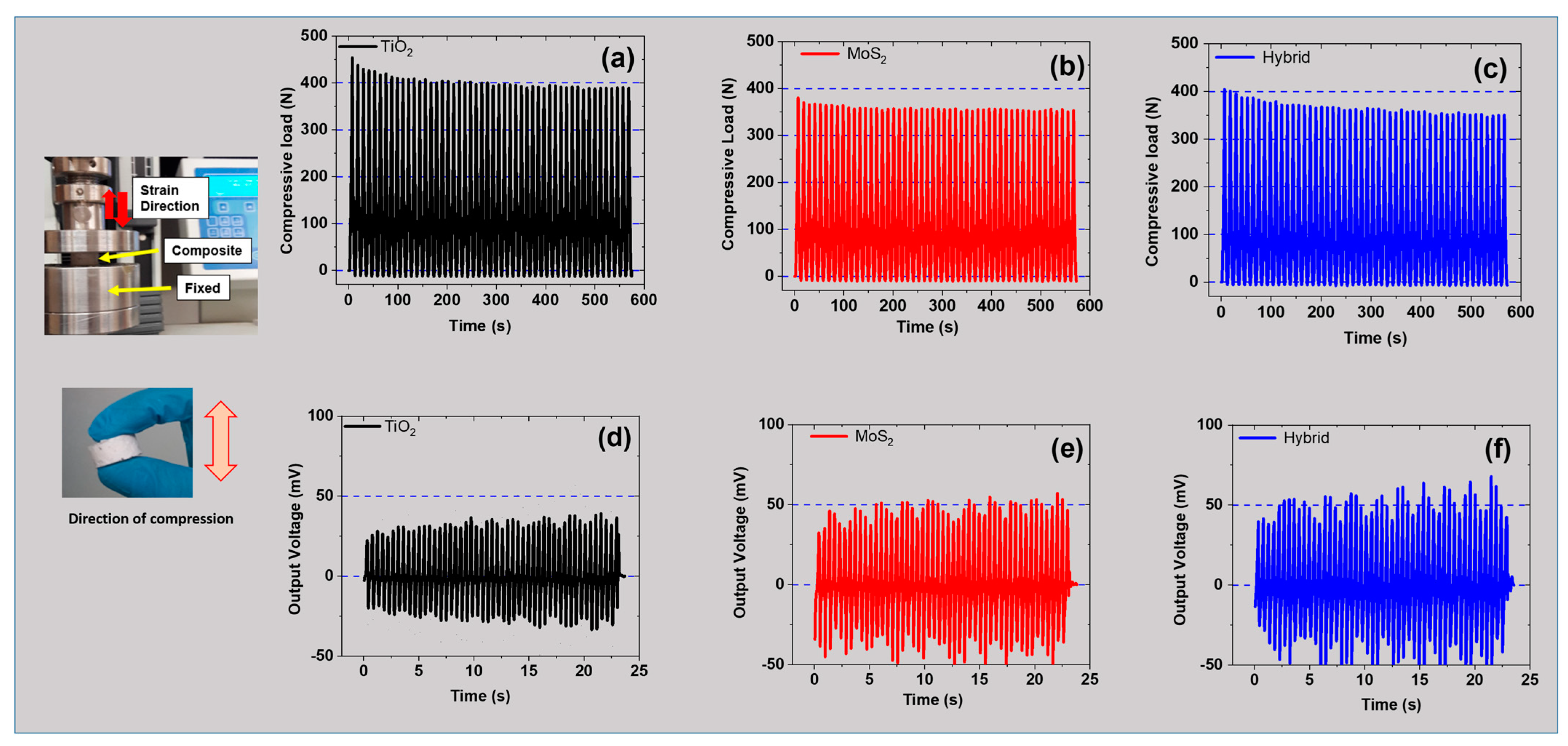
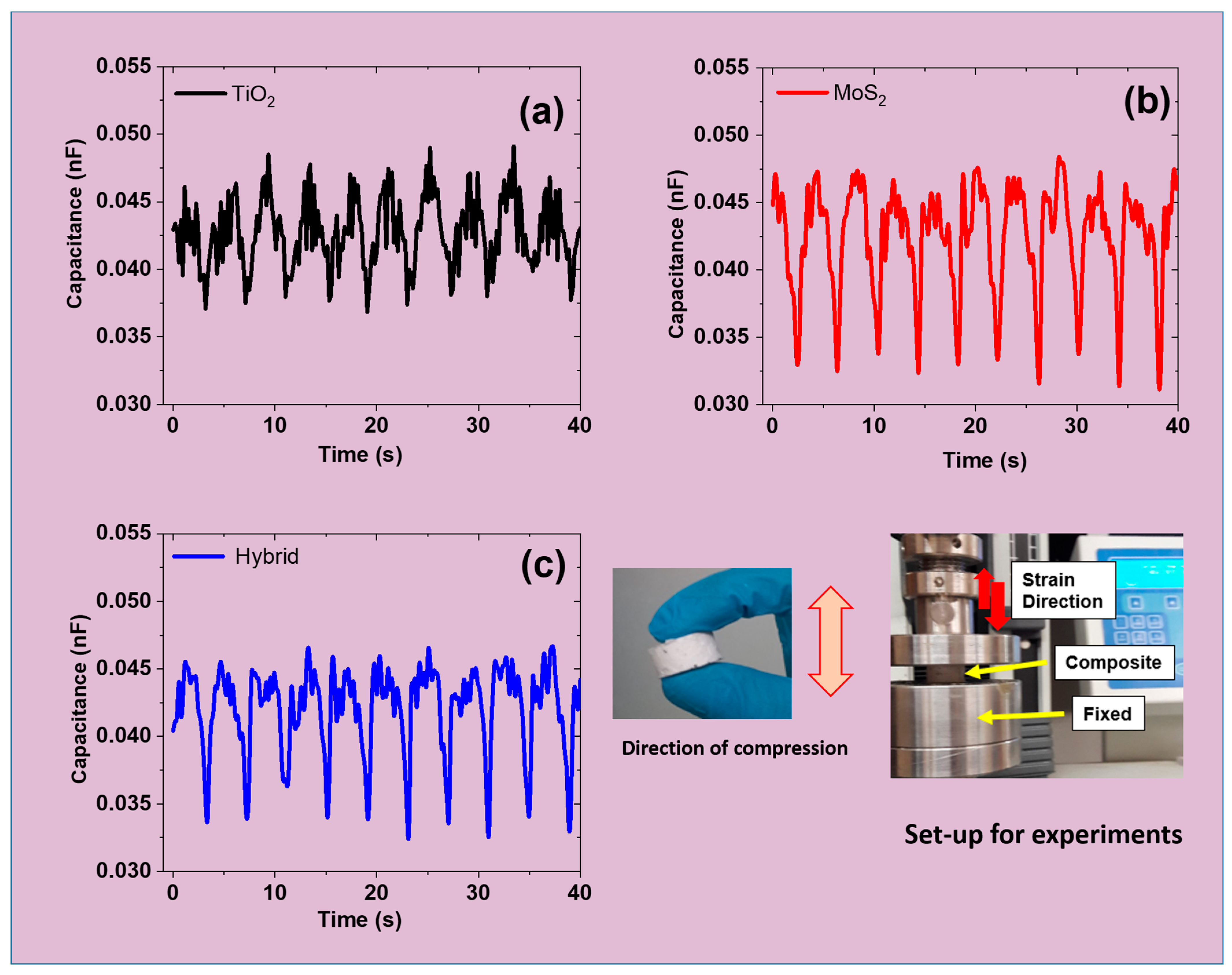

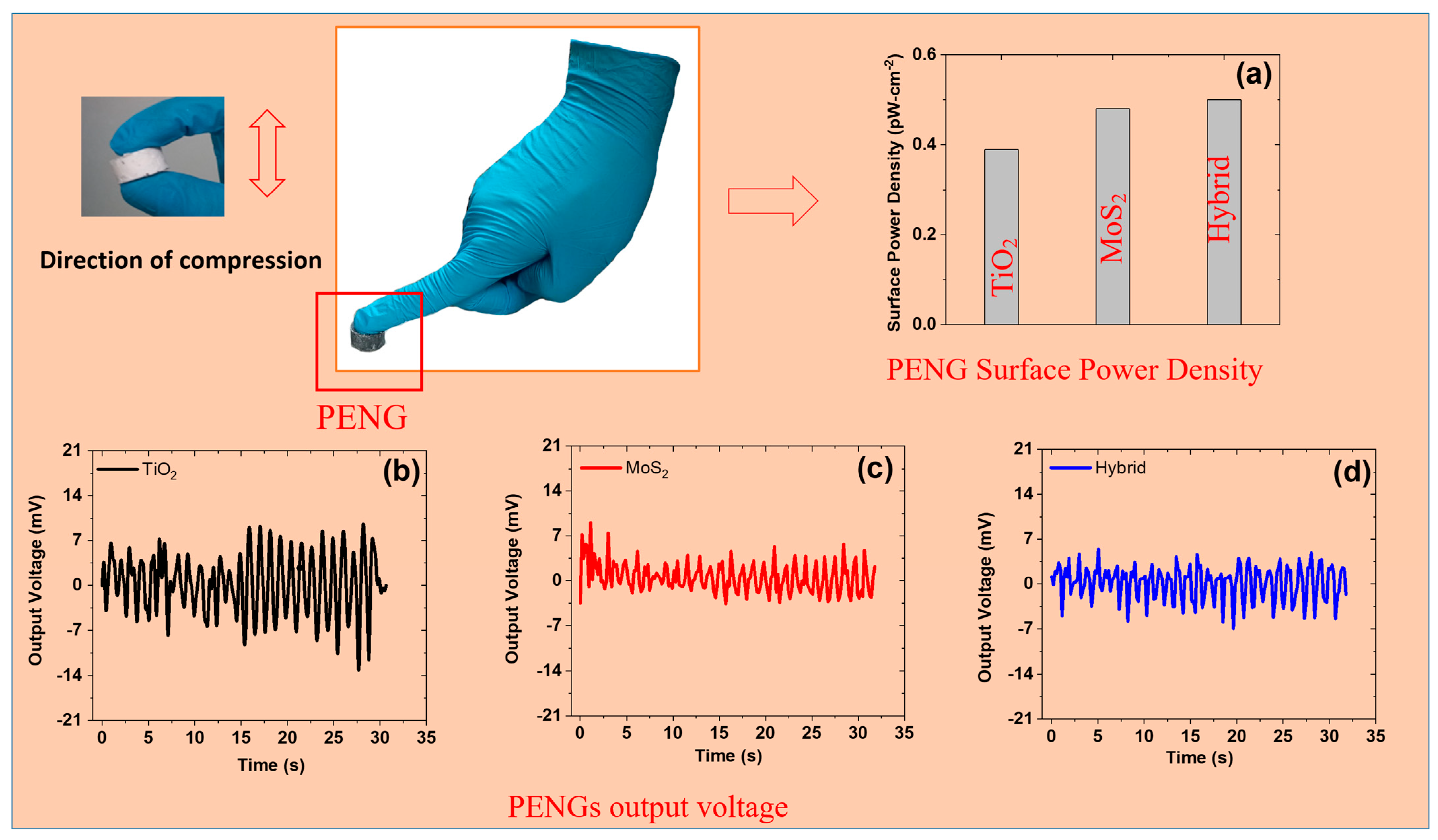

| Sample Details | Amount of Silicone Rubber | Amount of TiO2 | Amount of MoS2 | Amount of Vulcanization Agent |
|---|---|---|---|---|
| Control | 100 | - | - | 2 |
| TiO2 Composite | 100 | 3, 5, 8 | - | 2 |
| MoS2 Composite | 100 | - | 3, 5, 8 | 2 |
| Hybrid Composite | 100 | 1.5, 2.5, 4 | 1.5, 2.5, 4 | 2 |
Disclaimer/Publisher’s Note: The statements, opinions and data contained in all publications are solely those of the individual author(s) and contributor(s) and not of MDPI and/or the editor(s). MDPI and/or the editor(s) disclaim responsibility for any injury to people or property resulting from any ideas, methods, instructions or products referred to in the content. |
© 2025 by the authors. Licensee MDPI, Basel, Switzerland. This article is an open access article distributed under the terms and conditions of the Creative Commons Attribution (CC BY) license (https://creativecommons.org/licenses/by/4.0/).
Share and Cite
Kumar, V.; Alam, M.N.; Azam, S.; Park, S.S. Robust Composites Based on Silicone Rubber for Self-Powered Piezoelectric Nanogenerators. Polymers 2025, 17, 977. https://doi.org/10.3390/polym17070977
Kumar V, Alam MN, Azam S, Park SS. Robust Composites Based on Silicone Rubber for Self-Powered Piezoelectric Nanogenerators. Polymers. 2025; 17(7):977. https://doi.org/10.3390/polym17070977
Chicago/Turabian StyleKumar, Vineet, Md Najib Alam, Siraj Azam, and Sang Shin Park. 2025. "Robust Composites Based on Silicone Rubber for Self-Powered Piezoelectric Nanogenerators" Polymers 17, no. 7: 977. https://doi.org/10.3390/polym17070977
APA StyleKumar, V., Alam, M. N., Azam, S., & Park, S. S. (2025). Robust Composites Based on Silicone Rubber for Self-Powered Piezoelectric Nanogenerators. Polymers, 17(7), 977. https://doi.org/10.3390/polym17070977








